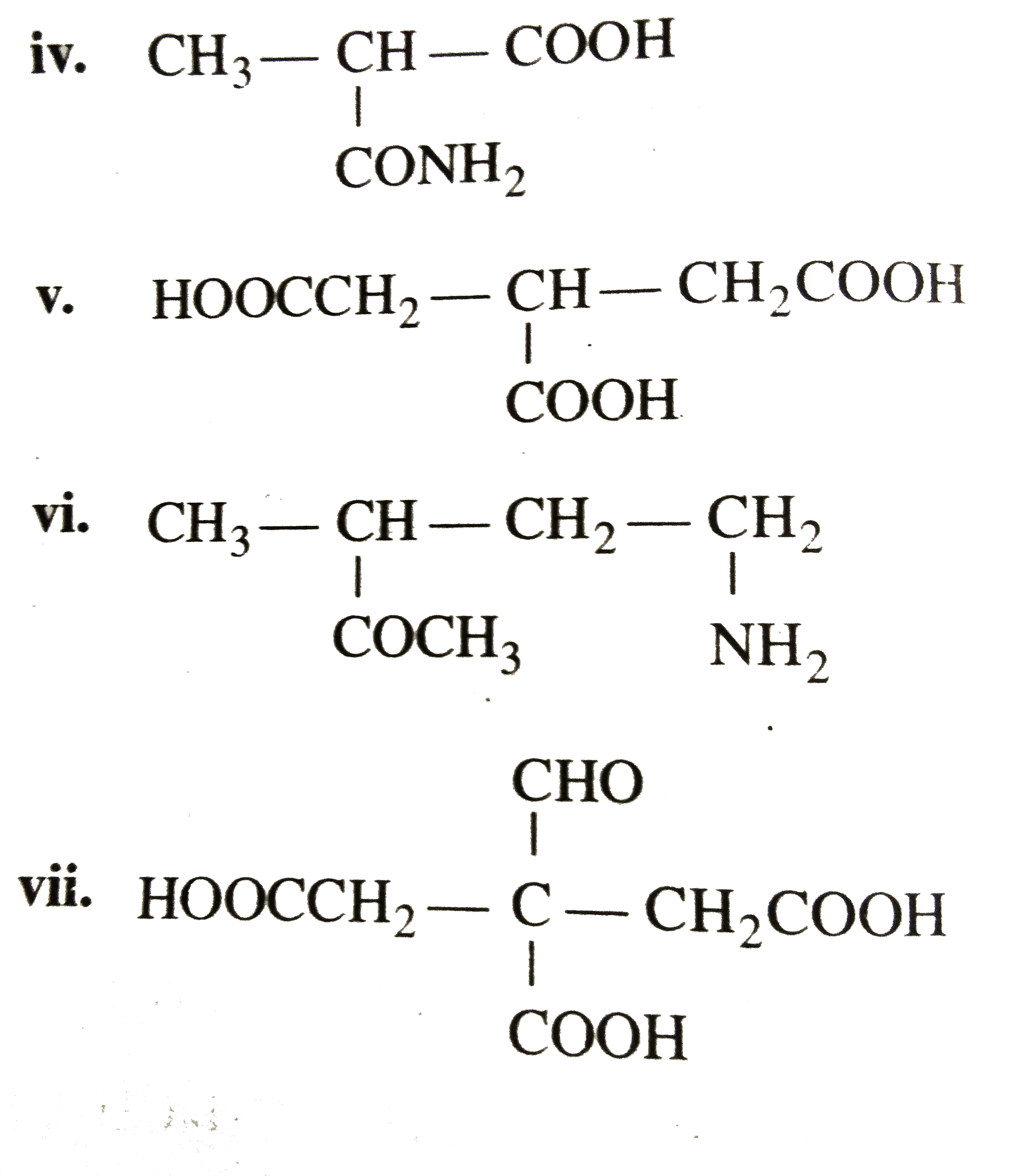Among the following four structures I to IV
I CH3 ∣C2H5−CH−C3H7
II O CH3 || |CH3−C−CH−C2H5
III H−H∣C⊕∣H
IV CH3∣C2H5−CH−C2H5 it is true that
all four are chiral compounds
only I and II are chiral compounds
only III is a chiral compound
only II and IV are chiral compounds
The correct Answer is:B
To determine which of the given structures (I to IV) are chiral compounds, we need to identify if they contain any asymmetric carbon centers. A chiral compound must have at least one carbon atom bonded to four different groups.
1. Analyze Structure I:
- The structure is represented as C2H5−CH−CH3−C3H7.
- Identify the carbon atom that may be chiral. The central carbon (attached to C2H5, CH3, C3H7, and H) has four different groups attached to it.
- Conclusion: Structure I is a chiral compound.
2. Analyze Structure II:
- The structure is represented as CH3−C(=O)−CH−CH2C2H5.
- Identify the chiral carbon. The carbon connected to CH3, C2H5, C=O, and H has four different groups.
- Conclusion: Structure II is also a chiral compound.
3. Analyze Structure III:
- The structure shows a carbon atom with four hydrogen atoms attached (H4C).
- Since all four substituents are the same (hydrogens), this carbon does not have four different groups attached.
- Conclusion: Structure III is not a chiral compound.
4. Analyze Structure IV:
- The structure is represented as C2H5−CH−CH2C2H5.
- The central carbon is attached to two C2H5 groups, making it impossible for it to be chiral as it does not have four different groups.
- Conclusion: Structure IV is not a chiral compound.
Final Conclusion:
- Structures I and II are chiral compounds.
- Structures III and IV are not chiral compounds.
Answer:
The correct option is B: Only I and II are chiral compounds.
---
- The structure is represented as C2H5−CH−CH3−C3H7.
- Identify the carbon atom that may be chiral. The central carbon (attached to C2H5, CH3, C3H7, and H) has four different groups attached to it.
- Conclusion: Structure I is a chiral compound.
- The structure is represented as CH3−C(=O)−CH−CH2C2H5.
- Identify the chiral carbon. The carbon connected to CH3, C2H5, C=O, and H has four different groups.
- Conclusion: Structure II is also a chiral compound.
- The structure shows a carbon atom with four hydrogen atoms attached (H4C).
- Since all four substituents are the same (hydrogens), this carbon does not have four different groups attached.
- Conclusion: Structure III is not a chiral compound.
- The structure is represented as C2H5−CH−CH2C2H5.
- The central carbon is attached to two C2H5 groups, making it impossible for it to be chiral as it does not have four different groups.
- Conclusion: Structure IV is not a chiral compound.
- Structures I and II are chiral compounds.
- Structures III and IV are not chiral compounds.
The correct option is B: Only I and II are chiral compounds.
Topper's Solved these Questions
- STEREOISOMERISMBOOK - RESONANCE ENGLISHCHAPTER - STEREOISOMERISMEXERCISE - EXERCISE (PART -II ONLINE JEE MAIN)
3 Videos
- STEREOISOMERISMBOOK - RESONANCE ENGLISHCHAPTER - STEREOISOMERISMEXERCISE - EXERCISE (ADDITIONAL PROBLEMS FOR SELF PRACTICE (APSP)) PART 1
30 Videos
- STEREOISOMERISMBOOK - RESONANCE ENGLISHCHAPTER - STEREOISOMERISMEXERCISE - EXERCISE (PART -1 JEE (ADVANCED))
16 Videos
- SOLUTIONSBOOK - RESONANCE ENGLISHCHAPTER - SOLUTIONSEXERCISE - Advabced Level Problems (PART-2)
35 Videos
- STRUCTURAL IDENTIFICATIONBOOK - RESONANCE ENGLISHCHAPTER - STRUCTURAL IDENTIFICATIONEXERCISE - Advanced level Problems (Part-III)
12 Videos
Similar Questions
Among the following four structures I to IV
(I) H5C2−CH3∣CH−C3H7
(II) H3C−O∣C−CH3∣CH−CH2H5
(III) H−H∣H+∣H
(IV) H5C2−CH3∣CH−C2H5
In is true that
View SolutionThe correct IUPAC name of the following compound is :
CH3CH2−C∣CH3H−CH=C∣C2H5−C2H5∣CH−CH2−CH2−CH2−CH3
View SolutionWrite the IUPAC name of the following compound:
H3C−N∣CH3− CH3∣C∣ C2H5−CH2−CH3
View SolutionFor the given four structures , I to IV, which of the following is correct ?
C2H5−CH3∣CH−C3H7(I) CH3−OPC−CH3∣CH−C2H5(II)CH3−OPC−C2H5∣CH−C2H5(III) C2H5−CH3∣CH−C2H5(IV)
View SolutionAmong the following structures I to IV :-
C2H5−CH3|CH−C3H7
(ii) CH3−O||C−CH3|CH−C2H5
(iii) H−H|C|H
(iv) C2H5−CH3|CH−C2H5
View SolutionCH3−C∣ClH−C∣IH−CH3
CH3−C∣CH3H−(CH2)4−C∣CH3H−C∣BrH−CH2CH3
View SolutionGive the IUPAC names for the following polyfunctional compounds:
i. CH3CH2O−CH2−CHOH−CH3
ii. CH3−C∣NO2H−CH2−CH3∣C∣OH−CH3
iii. CH2=H3C∣C−OH∣CH−CH2CN

View SolutionWrite the IUPAC names of the following :
(i) C2H5 C2H5 | |CH3−C−CH2−C−CH3 | | NO2 I
(ii) F Cl | |CH3−C−CH2−C−CH3 | | C2H5 C2H5
View SolutionWrite the IUPAC names of the following compounds:
(i) CH3−CH3∣CH−CH3−CH2−O∣∣C−CH2Cl
(ii) H2C−COOH∣HO−C−COOH∣H2C−COOH
View SolutionCH3CH2−O∣∣C−O−C2H2(i)DIBAL.H(1eq)−−−−−−−−−−−−→(ii)H3O+A+B A and B are respectively.
View Solution
